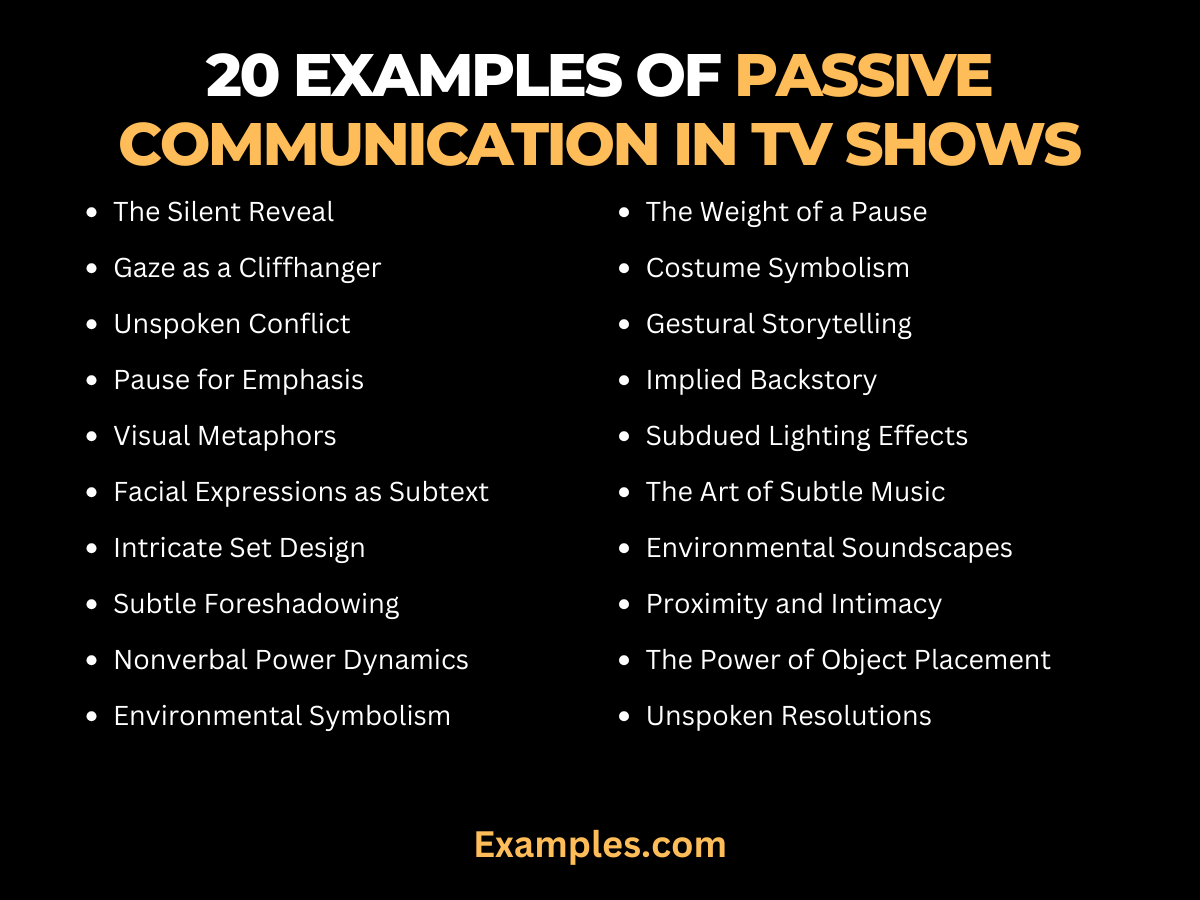19+ Passive Communication in Tv shows Examples
Embark on an illuminating journey into the art of passive communication within the realm of TV shows. This comprehensive guide unravels the deliberate nonverbal choices, character dynamics, and plot twists that make these shows compelling. Immerse yourself in the world of scripted communication, enriched with Communication Examples, and explore how subtle cues, gestures, and silences contribute to the captivating narratives and unforgettable moments we cherish on the screen.
20 Examples of Passive Communication in Tv Shows
Unlock the allure of Passive Communication in TV shows, where nuanced nonverbal cues yield a spectrum of benefits. Explore improved character connections, heightened suspense, and immersive storytelling. This guide delves into the strategic use of subtleties, shaping the viewer experience and elevating the impact of on-screen communication.

- The Silent Reveal: Bold character revelations without words, leaving viewers in suspense, exemplified in moments like a dramatic unmasking.
- Gaze as a Cliff-hanger: Prolonged eye contact building tension, heightening anticipation for upcoming plot twists in cliff-hanger scenes.
- Unspoken Conflict: Character tension portrayed through body language, emphasizing conflicts without explicit verbal confrontation.
- Pause for Emphasis: Strategic silences, punctuating dialogue for emotional impact, enhancing the gravitas of critical moments.
- Visual Metaphors: Symbolic visuals conveying deeper meanings, exemplified by recurring motifs or subtle background details.
- Facial Expressions as Subtext: Characters conveying hidden emotions through facial expressions, allowing viewers to discern underlying motives.
- Intricate Set Design: Nonverbal storytelling through meticulously crafted sets, providing context and enhancing narrative authenticity.
- Subtle Foreshadowing: Incorporating subtle hints in scenes or dialogue, guiding viewers toward future plot developments.
- Nonverbal Power Dynamics: Depicting character hierarchy through subtle positioning, allowing viewers to infer relationships without explicit dialogue.
- Environmental Symbolism: Using settings as silent communicators, reflecting character moods or foreshadowing events to come.
- The Weight of a Pause: Strategic pauses in dialogue creating anticipation, building suspense and emphasizing key plot points.
- Costume Symbolism: Character traits subtly expressed through wardrobe choices, providing visual cues to complement their personalities.
- Gestural Storytelling: Conveying intricate plot details through character gestures, enabling a deeper understanding of unfolding narratives.
- Implied Backstory: Nonverbal clues hinting at character backgrounds, allowing viewers to piece together their histories.
- Subdued Lighting Effects: Shifting lighting dynamics symbolizing mood changes, guiding viewers’ emotional responses.
- The Art of Subtle Music: Musical cues enhancing emotional impact, creating an atmosphere that complements unspoken moments.
- Environmental Soundscapes: Background noises shaping mood and context, contributing to the overall immersive storytelling experience.
- Proximity and Intimacy: Character relationships depicted through physical closeness, signalling emotional bonds without overt declarations.
- The Power of Object Placement: Strategic placement of objects conveying narrative significance, acting as visual storytelling elements.
- Unspoken Resolutions: Conflict resolution portrayed through actions, allowing characters to mend relationships without verbal exchanges.
Importance of Passive Communication in TV Shows
Unlock the significance of passive communication in TV shows, where subtle nonverbal cues play a pivotal role in shaping character dynamics, enhancing plot intricacies, and captivating audiences. This silent language enriches storytelling, creating a layered viewing experience that transcends dialogue. Dive into the essence of silent communication, exploring its profound impact on the immersive world of television narratives.
- Expressive Wardrobe Choices: Characters silently convey their personality traits through wardrobe selections, offering viewers visual insights into their identities and story arcs.
- Symbolic Colour Schemes: Strategic use of colours in sets and costumes symbolizes themes, emotions, or character developments, contributing a nonverbal layer to the narrative.
- Temporal Nonlinearity: Nonlinear timelines communicate complex plots without explicit exposition, engaging viewers through a puzzle-like unravelling of events.
- Weather as Emotion: The choice of weather conditions reflects characters’ emotional states, enhancing the mood and intensifying the impact of key scenes.
- Unspoken Gestures of Affection: Characters express love and connection through subtle gestures like a shared look or a gentle touch, fostering emotional bonds without verbal declarations.
- Visual Punctuation with Props: Meaningful props serve as visual punctuation, emphasizing key moments and adding layers to the narrative without relying on spoken words.
- Seasonal Symbolism: Seasons subtly mirror character arcs and plot progression, using nature’s cycles as a nonverbal metaphor for the evolution of the story.
- Background Soundscapes: Nonintrusive background sounds contribute to the atmosphere, creating a sensory experience that complements the unfolding narrative without explicit communication.
- Evocative Soundtrack Choices: Musical selections heighten emotional resonance, crafting an auditory backdrop that enhances viewer engagement and connection to the story.
- Strategic Silence in Dialogue: Purposeful moments of silence in dialogues allow viewers to absorb and interpret information, encouraging active engagement and thoughtful reflection.
Role of Passive Communication in TV Shows
Passive communication in TV shows serves as a silent orchestrator, intricately weaving a tapestry of emotions, relationships, and plot developments. Explore the multifaceted roles of nonverbal cues in shaping the storytelling landscape and enhancing viewer engagement. From character nuances to plot twists, delve into the profound impact of silent expressions, visual metaphors, and atmospheric elements that elevate TV narratives beyond spoken words.
- Character Depth and Nuances: Nonverbal cues breathe life into characters, conveying unspoken emotions, hidden motives, and intricate personality nuances that deepen the audience’s connection.
- Plot Development Through Subtext: Silent communication becomes a powerful tool for advancing plotlines, with subtle hints, gestures, and environmental cues guiding viewers through intricate narrative arcs.
- Building Tension and Suspense: Passive communication masterfully crafts tension and suspense, utilizing visual cues, pauses, and strategic silences to heighten anticipation and create memorable cliff-hangers.
- Foreshadowing and Symbolism: Silent elements foreshadow future events and inject symbolic depth into storylines, allowing viewers to interpret and anticipate narrative developments.
- Relationship Dynamics Without Words: The nonverbal language in TV shows navigates the complexities of relationships, portraying intimacy, conflict, and camaraderie through gestures, expressions, and proximity.
- Enhancing Visual Storytelling: Passive communication acts as a visual storyteller, complementing verbal narratives with the artful use of settings, lighting, and visual metaphors to enrich the viewing experience.
- Conveying Ambiance and Mood: Atmosphere and mood are crafted through nonverbal elements, influencing the emotional tone of scenes and establishing the overarching ambiance of the TV show.
- Character Arcs and Growth: The subtleties of passive communication track character evolution, conveying personal growth, internal conflicts, and transformative journeys without explicit verbal exposition.
- Viewer Engagement and Interpretation: Encouraging active engagement, passive communication invites viewers to interpret scenes, decode symbolism, and emotionally invest in the unfolding narrative.
- Cultural and Contextual Significance: Silent communication in TV shows often incorporates cultural and contextual nuances, allowing for a richer, more immersive storytelling experience that resonates with diverse audiences.
Tips for Effective Passive Communication in TV Shows
Unlock the secrets to harnessing passive communication effectively within the realm of television narratives. This comprehensive guide offers actionable tips to writers, directors, and actors, enhancing the subtleties that make TV shows memorable. Dive into the nuances of silent expression, from visual storytelling to character dynamics, and elevate your approach to crafting compelling narratives.
- Strategic Visual Cues: Learn how to employ visual cues such as props, settings, and colours to communicate subtle messages, enhancing the depth of your TV show’s narrative.
- Sub textual Dialogue Crafting: Explore techniques for infusing dialogues with subtext, allowing characters to convey deeper emotions and intentions without explicitly verbalizing them.
- Mastering Nonverbal Acting: Delve into the art of nonverbal acting, teaching actors how to convey emotions, relationships, and plot developments through nuanced facial expressions and body language.
- Utilizing Silence for Impact: Understand the power of silence and how deliberately incorporating moments of quietude can amplify the emotional impact of key scenes in your TV show.
- Symbolism in Set Design: Discover the impact of symbolic set design, where every detail contributes to the narrative, providing additional layers of meaning without explicit communication.
- Building Character Chemistry Nonverbally: Gain insights into fostering on-screen relationships through nonverbal cues, establishing chemistry between characters that resonates with the audience.
- Playing with Time: Learn to manipulate temporal elements, exploring nonlinearity and flashback techniques to communicate complex plots without excessive exposition.
- Nonintrusive Soundscapes: Explore the use of background sounds and music that complement the narrative without overpowering it, creating a sensory experience that enhances passive communication.
- Emotional Punctuation with Music: Understand how the strategic use of music can punctuate emotional beats in your TV show, guiding viewers’ emotional responses and enriching the viewing experience.
- Balancing Subtlety and Clarity: Find the delicate balance between subtle nonverbal communication and ensuring clarity in storytelling, ensuring that passive elements enhance, not obscure, the narrative thread.
In the world of TV shows, passive communication emerges as a powerful narrative tool. Through nuanced performances, characters convey emotions, intentions, and conflicts without explicit dialogue. This guide delved into the subtle art of passive communication, offering insights and examples. Now, armed with a comprehensive understanding, viewers can appreciate the depth and complexity that unfolds silently on their screens.



